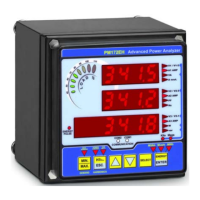16
2. Read the V1 channel header data through the corresponding waveform header transfer
block. The record data is moved to the port’s communication buffer, and then the file
pointer automatically moves to the next record.
3. Read the V1 channel sample series through the waveform series transfer block.
4. Read the next channel’s header data through the corresponding waveform header
transfer block.
5. Read the sample series for the selected channel through the waveform series transfer
block.
6. Repeat steps 4, 5 until all channels’ records are read.
7. Repeat steps 2-6 until all the file records are read.
Reading Real-time Waveforms
Real-time waveforms are accessed through the separate transfer blocks just like the
waveform log data. The meter provides a large waveform buffer that can simultaneously
store 6 waveform records – three voltage and three current waveforms. Each time you read
the V1 channel header record, the meter captures new waveforms to the buffer so that you
can then read all of them through the waveform transfer blocks. The following gives a
summary of steps for reading real-time waveforms:
1. Read the V1 channel header data through the corresponding real-time waveform header
transfer block. The captured waveform’s data is moved to the port’s communication
buffer.
2. Read the V1 channel sample series through the waveform series transfer block.
3. Read the next channel’s header data through the corresponding waveform header
transfer block.
4. Read the sample series for the selected channel through the waveform series transfer
block.
5. Repeat steps 3, 4 until all channels’ records are read.
2.10 TCP Notification Client
The TCP notification client can establish connections with a remote Modbus/TCP server and send
notification messages either on events, or periodically on a time basis.
Notification messages are sent via a block of 16 Modbus registers using write function 16. The
following table shows the message exchange structure.
Modbus
Register
Description Type Comment
+0-1 Device serial number UINT32
+2-4 Device MAC address CHAR6
+5 Device address UINT16 Device port address
+6-7 Device IP address UINT32 Network byte order
+8 Event type UINT16 See F22 in Section 5
+9 Event sequence number UINT16
+10-11 Event timestamp, seconds UINT32 Local time since Jan 1, 1970
+12-13 Event timestamp, seconds fraction, in microseconds UINT32
+14-15 Reserved UINT32 Written as 0
After receiving a write acknowledgement from a server, a TCP connection is still open for 10
seconds (20 seconds via GPRS) to give the server an opportunity to access meter registers
through an open socket. It may help you access the meter from outside your local
network when the server is located on another network, or when using wireless GPRS
communications. The notification client will respond to all server requests as if it were a regular
incoming connection.

